Early entrepreneurs: settlers and citizens
The number of French people residing in Australia in the first half of the 19th century has been estimated as less than 600.
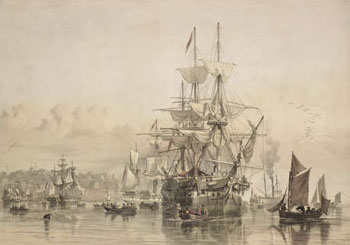
Sydney Cove - emigrants leaving ship, c.1851, by Oswald Brierly
Hand coloured engraving DG V1/7
The French who came out to the Australian colonies tended to be professionals (teachers, qualified tradesmen, merchants, agriculturalists) or people with a high degree of entrepreneurial initiative.
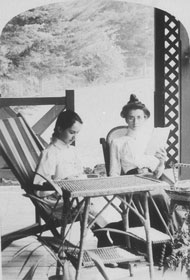
Detail from Miss Gouley, French governess, at "Sandilands" station, NSW
Photograph BCP - 06917
French settlers soon made their mark, whether as landowners or business people. Tending to 'marry out' of their nationality rather than form closely knit ethnic groups, French migrants blended smoothly into the community. Combining the best of the old and new worlds, they seized the opportunities offered in colonial Australia while adding an air of continental glamour to the local scene.
Public servant: Francis Rossi
Ownership of land has always been important to the French. When challenged over his rights to hold land in the colony, Francis Rossi (1776 - 1851) sought naturalisation. Born in Corsica, his father, the Count of Rossi, was dispossessed when the French took over the island in 1796. Francis joined the British army in 1795. In 1824, Earl Bathurst offered him the position of Superintendent of Police in NSW. Rossi arrived in the colony with his wife and two sons in 1825.
Rossi's tenure as Superintendent of Police lasted nine years, during which time he acquired extensive land holdings in the Goulburn district which he named Rossiville. Retiring to his property in 1834, on two occasions his right to own land in the colony was challenged. The NSW Legislative Assembly finally passed an Act to confirm Rossi's ownership rights, thereby securing the land for his heirs. Francis Rossi died at Rossiville in 1851.
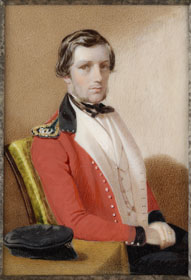
Member of the Rossi family, c.1845, by unknown artist
Watercolour on ivory MIN 87
> Search the Library's catalogue for collections relating to Francis Rossi (1776-1851) ![]()
Inventor: Eugène D. Nicolle
After the 1848 revolution, Eugène Dominique Nicolle (1823 - 1909) came to Australia to pursue his career as an engineer. Arriving in Sydney in 1853 with his first wife, Nicolle registered his initial patent for an ice-making machine jointly with Richard Dawson in 1861.
Together with the Wilkinson brothers, they bought the Sydney Ice Company (subsequently renamed the NSW Ice Company) and began making ice with Nicolle's machine in 1863. With his partners, Nicolle designed and built a variety of cooling apparatus for both domestic and industrial use. They demonstrated that it was both possible and safe to freeze food for long periods and then thaw it for human consumption.
Nicolle eventually secured the financial backing of Thomas Sutcliffe Mort for his experiments, which were often conducted at the Nicolle family home in Burwood, NSW. Although Nicolle and Mort were ultimately unsuccessful in their attempts to ship frozen meat overseas, they were awarded a gold medal at the 1874 Metropolitan Exhibition for their refrigerating machines.
> Search the Library's catalogue for collections relating to Eugene Nicolle (1823-1909) ![]()
Prospectors and speculators
When gold was discovered in NSW in 1851, the ensuing frenzy brought hundreds of thousands of people of all classes and nationalities together on the goldfields.
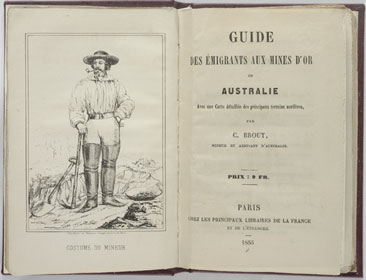
Detail from 'Costume du mineur', Guide aux mines d'or en Australie, 1855, by M.C. Brout
Printed book 980.1/B
Contrary to the lifestyle portrayed by images like 'Costume du mineur', published in a French guide book to the Australian goldfields, mining was dirty, backbreaking work. Many prospectors soon gave up digging to set up businesses catering to the needs of other miners and their families. Those with practical, portable skills (such as chefs or tailors) were best placed when seeking their fortunes in far flung lands.
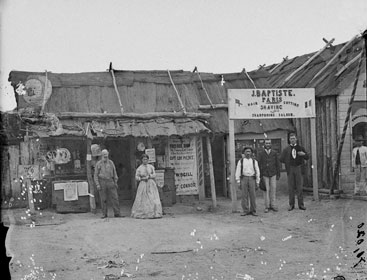
J. Baptiste's hairdressing salon, Hill End, c.1875, by AAPC
Glass plate negative ON 4/ Box 9/ 70020
Given his somewhat dishevelled appearance and telltale suntan, J. Baptiste was probably still a part-time prospector when he posed (far left) under the billboard which proudly proclaimed the Parisian connections of his 'Hair cutting, shaving and shampooing saloon' at Hill End, NSW.
Property developers: the French village
The Joubert brothers, Didier (1816-1881) and Jules (1824-1907), were entrepreneurs and property developers who predicted by decades Sydneysiders' penchant for houses with water views. Didier, a wine merchant, came to Sydney in 1837, while Jules finally settled there in about 1853.
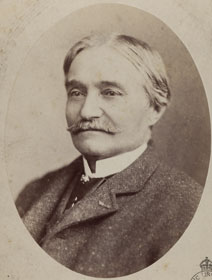
Jules Joubert, c.1870, by Hubert Newman
Photograph P1/JOUBERT
Before the arrival of these French property developers, Hunters Hill was considered to be a rather unrespectable area. Didier and Jules Joubert saw its potential and conceived the idea of subdividing the land into deep narrow blocks, each with water access and views - looking onto either the Lane Cove or Parramatta Rivers - with a road running along the length of the ridge of the peninsula.
Detail from Views of Hunters Hill, c.1860, Manning Family Album
The Jouberts also saw the potential of ferries as a fast and efficient way of linking Hunters Hill to Sydney, and established the Lane Cove River ferry service in the 1860s. The convivial atmosphere the Jouberts created encouraged other expatriates to follow them to the suburb which, for a time, became known as the French Village.



